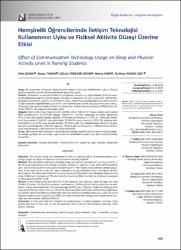| dc.contributor.author | Çulha, Yeliz | |
| dc.contributor.author | Turan, Nuray | |
| dc.contributor.author | Özdemir Aydın, Gülsün | |
| dc.contributor.author | Kaya, Hatice | |
| dc.contributor.author | Atabek Aştı, Türkinaz | |
| dc.date.accessioned | 2022-05-11T14:48:54Z | |
| dc.date.available | 2022-05-11T14:48:54Z | |
| dc.date.issued | 2020 | |
| dc.identifier.issn | 2149-4983 | |
| dc.identifier.issn | 2149-9306 | |
| dc.identifier.uri | https://doi.org/10.5222/jaren.2020.17894 | |
| dc.identifier.uri | https://app.trdizin.gov.tr/makale/TkRJek1qZ3dNQT09 | |
| dc.identifier.uri | https://hdl.handle.net/20.500.11776/10701 | |
| dc.description.abstract | Amaç: Bu araştırma, hemşirelik öğrencilerinde iletişim teknolojisi kullanımının uyku ve fizikselaktivite düzeyleri üzerine etkisini belirlemek amacı ile yapıldı.Yöntem: Tanımlayıcı ve kesitsel türdeki bu çalışmanın, evrenini bir sağlık bilimleri fakültesi hemşirelik bölümünde öğrenim gören toplam 215 öğrenci oluşturdu. Bu evren arasından 188 öğrenci,gelişigüzel örnekleme yöntemi ile örnekleme alındı. Araştırmaya başlamadan önce etik kurul iznive öğrencilerden bilgilendirilmiş olur alındı. Veri toplama aracı olarak, Yapılandırılmış Soru Formu,Pitsburgh Uyku Kalitesi İndeksi (PUKİ) ve Uluslararası Fiziksel Aktivite Envanteri (IPAQ) kullanıldı.Veriler SPSS 21.00 programında analiz edildi.Bulgular: Öğrencilerin yaş ortalamalarının 20.68±1.83 yıl, %86.17’sinin kadın, Beden Kitle İndeksi(BKİ) ortalamasının 21.37±3.46 olduğu, %93.6’sının internet kullandığı ve yatak odalarında%79.3’ünde akıllı telefon olduğu saptandı. PUKİ puan ortalamasının 7.74±3.41, öznel uyku kalitesi alt boyutunda 0.13±0.42, uyku latensinde 1.81±0.74, uyku süresinde 1.07±1.00, alışılmış uykuetkinliğinde 0.61±0.94, uyku bozukluğunda 1.91±0.63, uyku ilacı kullanımında 0.85±0.98 ve gündüz işlev bozukluğunda 2.18±1.49 saptandı. IPAQ’ya göre ise hesaplanan haftalık enerji tüketimipuan ortalamasının 1388.04±1644.24 olduğu belirlendi.Sonuç: Öğrencilerin uyku kalitesinin düşük düzeyde olduğu haftalık enerji miktarının düşük değerde olduğu görüldü. Bu durumda, uyku öncesinde teknolojik araçların çok fazla kullanılmamasıönerilebilir | en_US |
| dc.description.abstract | Objective: The present study was conducted in order to examine effect of communication technology usage on sleep and physical activity level in nursing students. Method: This descriptive and cross-sectional study was carried out with 215 nursing students in the Nursing Department of a Faculty of Health Sciences in Istanbul in the 2016-2017 academic year. 188 nursing students who agreed to participate in the study constituted the sample group. Prior to the start of the study, the ethics committee was granted permission and informed from the students. The data were collected by using Structured Question Form, Pitsburgh Sleep Quality Index (PSQI) and International Physical Activity Inventory (IPAQ short form). Data were analyzed in the program of SPSS 21.00 . Results: It was determined that 86.17% of the students were female, their average age was 20.68±1.83 years, 93.6% of the students used internet, 79.3% of them had smartphones in bedrooms. It was determined that the point average of PSQI was 7.74±3.41, Subjective Sleep Quality subscale 0.13±0.42, Sleep Latency 1.81±0.74, Sleep Duration 1.07±1,00, Habitual Sleep Efficiency 0.61±0.94, Sleep Disturbances 0.85±0.98 in the Use of Sleeping Medications and 2.18±1.49 in the Daytime Dysfunctioan. According to IPAQ, the calculated weekly energy consumption point average was determined 1388.04±1644.24. Conclusion: It was seen that the amount of weekly energy in which students had poor sleep quality was low. In this case, it may be advisable not to use the technological tools too much before sleeping. | en_US |
| dc.language.iso | tur | en_US |
| dc.identifier.doi | 10.5222/jaren.2020.17894 | |
| dc.rights | info:eu-repo/semantics/openAccess | en_US |
| dc.title | Hemşirelik Öğrencilerinde İletişim Teknolojisi Kullanımının Uyku ve Fiziksel Aktivite Düzeyi Üzerine Etkisi | en_US |
| dc.title.alternative | Effect of Communication Technology Usage on Sleep and Physical Activity Level in Nursing Students | en_US |
| dc.type | article | en_US |
| dc.relation.ispartof | Journal of Academic Research in Nursing | en_US |
| dc.department | Yüksekokullar, Sağlık Yüksekokulu, Hemşirelik Bölümü | en_US |
| dc.identifier.volume | 6 | en_US |
| dc.identifier.issue | 3 | en_US |
| dc.identifier.startpage | 433 | en_US |
| dc.identifier.endpage | 441 | en_US |
| dc.institutionauthor | Özdemir Aydın, Gülsün | |
| dc.identifier.trdizinid | TkRJek1qZ3dNQT09 | en_US |



















